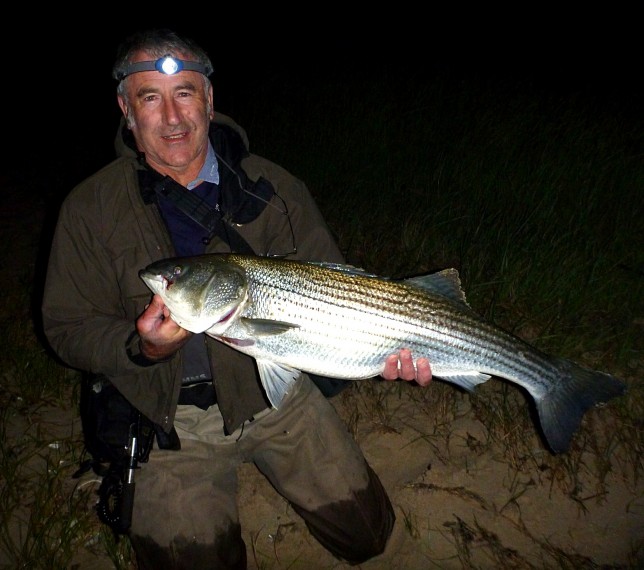I am not sure exactly which year class Malcolm Gilbert came from, but he has been fighting the corner for our bass for many years. Here he indicates how the structure of our bass populations are overrepresented by occasional years where successful spawning is followed by high rates of fry survival. Given the failure to control the unsustainable levels of exploitation of our bass and the length of time since we had a strong year class, things it seem, look bad:

Class matters
During 2012, my catches (all from my kayak) from the western end of Cornwall comprised significant numbers of bass measuring 37 – 39 cm (about 550 g in weight) . I scale-read a few and they were all 2007 fish. Last year (2013), the 2007 cohort were still present in reasonable numbers, measuring 40 -43 cm (about 750 g). Similarly, although numbers are reduced, the 2002 cohort is still showing up and are now ‘good’ fish.
In 2012 I managed to find a few of the ten year olds which all exceeded 55cm (1.6kg) and last year I caught four of them all measuring 60+ cm and weighing between almost five pounds to just over six pounds. This just confirms the enormous importance of good year classes. I recall the Kennedy and Fitzmaurice paper on Irish bass published back in the 1960’s when the exceptional 1959 year class was contributing more than 50% by numbers of all bass caught during 1967/8.
Over the long term, historically, we benefited from a bumper year class about every decade. 1949, 1959, 1969, 1976 — – – – – . Between these ‘bonanza’ years, recruitment was highly variable and when during the seventies, we enjoyed a succession of reasonable year classes [1973, 1974, 1975, 1976 (fantastic), and 1977] bass fishing during subsequent years as the succession of cohorts matured really was excellent.
In the mean time, effort, both recreational and commercial was escalating and each cohort was being fished out increasingly quickly. For example, the 1959 year class was throwing up good catches of double figure bass as late as the late seventies – 20 years later. However, the 1976 year class was subjected to far higher levels of fishing mortality and relatively few survived past twelve years of age.
Then along came 1989, another absolutely fabulous year class followed by an unprecedented succession of good to excellent year classes through most of the nineties. Despite this wonderful productivity, by now, commercial effort had spiralled upwards and the fishery effectively became a recruitment fishery with massive levels of mortality inflicted upon each cohort as soon as it recruited to the fishery, in other words as soon as they reached the legal retention size, they were snaffled.
From a commercial fishery perspective, this is fine whilst productivity is maintained. And it pretty well was until 2008. All indications are that 2008, 2009, 2010, 2011, 2012 and 2013 are either moderate or poor year classes. We are about to see the availability of bass recruiting to the fishery at the current MLS of 36cm take a significant downward turn.
Meanwhile, effort remains high. We’re entering a period where far fewer bass are going to recruit to the fishery at ages 6+. For a period, landings may well be supported by a slight shift in effort towards the remaining older and larger fish. Fishermen will naturally target what ever they can find and since the “only game in town” will be the remaining older and larger fish from pre- 2008 i.e. those from the 2007 and previous cohorts, the additional weight per recruit may help to maintain landings by weight for a while [the weight of an 8 year old bass is twice that of a 5 year old] but eventually, all the indications are that we are about to witness a collapse in the fisheries.
Hence, ICES latest advice for a 36% reduction in bass landings for THIS YEAR. Such advice is of course meaningless since there is no methodology of achieving such a cut in catches and politically – and fisheries management across Europe is far more about politics than evidence based decision making – no politician wants to be the deliverer of bad news.
When I look back over the considerable correspondence I enjoyed with Donovan Kelley since the early 1970’s, and consider where we are now with management of such a wonderful species, I feel so sad, and dare I say, a little bitter.
I can’t end without reflecting on how different the situation would have been if the Fisheries Minister Ben Bradshaw’s intention to increase the MLS to 40 cms and then to 45 cm two years later, hadn’t been scuppered by his replacement Jonathan Shaw. A major element of the Bass Management Plan (BMP) produced by the BASS was how an increased MLS would provide protection for the good 2002 year class. Had it gone ahead, we would now still be enjoying a far higher proportion of the 2002 fish and the 2007 year class would only now (2014) be recruiting to the fishery and at this moment be totally intact. That would have bought us some time.
Ultimately, since there has been neither the will nor mechanism to follow the ICES scientific advice, and with a 36 cm MLS, we are now destined to see, over the next two or three years, a rapid collapse of both commercial landings and the valuable recreational bass fishery. I guess, once the collapse has manifested itself, then, there may be an appetite to do the right thing and introduce a package of sufficiently restrictive management measures to rebuild the stocks.
Should it really have taken the horse to be on the motorway causing mayhem, before we fixed the stable door?